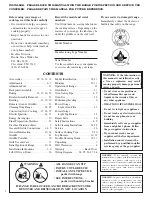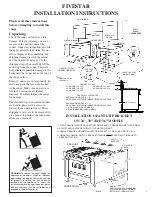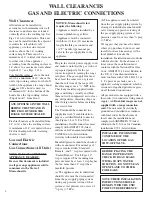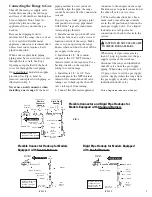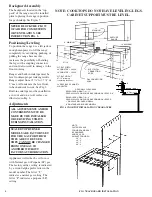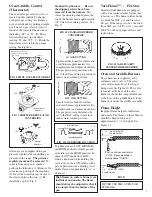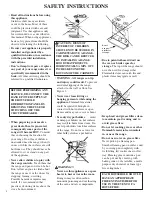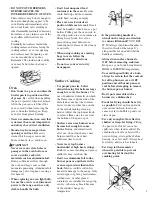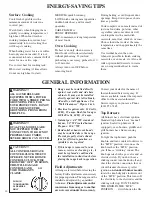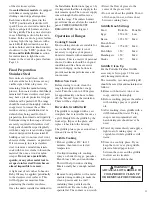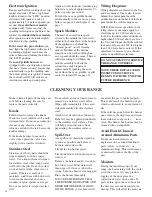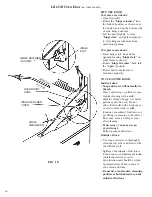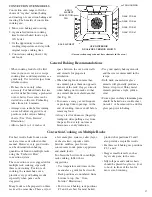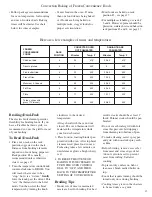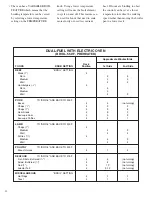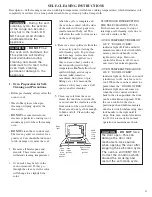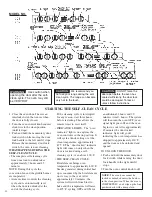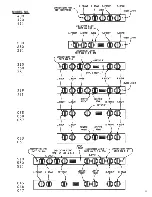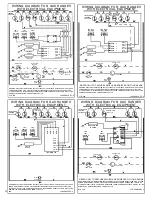
9
• DO NOT TOUCH BURNERS,
BURNER GRATES, OR
INTERIOR SURFACE OF OVEN.
These surfaces may be hot enough to
burn even though they appear to be
cool. During and immediately after
use do not touch, or let clothing or
other flammable materials contact any
hot surfaces or any interior area of the
oven; allow sufficient time for
cooling.
Potentially hot surfaces include the
cooking surface and areas facing the
cooking surface, oven vent opening
and surfaces near the opening, and
crevices around the oven door.
Remember: The inside surface of the
oven may be hot when the door is
opened.
• Don’t heat unopened food
containers in the oven.
Pressure
could build up and the container
could burst causing an injury.
• Place oven rack in desired
position while oven is cool.
If rack
must be handled when hot use a pot
holder. Pulling out the oven rack to
the stop position is a convenience in
lifting heavy foods. It is also a
precaution against burns from
touching hot surfaces of the door or
oven walls.
• When using cooking or roasting
bags in oven, follow the
manufacturer’s directions.
• Do not use your oven to dry
newspapers.
Surface Cooking
• Use proper pan size. Select
utensils having flat bottoms large
enough to cover the burner.
The
use of undersized utensils in which
the flame comes up the side of the
utensil does not heat the contents
faster, it only scorches the outside
of the utensil making clean up
harder. Adjust the top burner knob
to select a flame size to cover just
the bottom of the pan or pot.
• Surface areas near burners may
become hot enough to cause
burns.
During and immediately
after use, do not touch areas near
burners until they have had
sufficient time to cool.
• Never leave top burners
unattended at high heat settings.
Boilover causes smoking and greasy
spillovers may catch on fire.
• Don’t use aluminum foil to line
burner pans or anywhere in the
oven except as described in this
book.
Misuse could result in fire
hazard or damage to the range. Only
certain types of glass, glass/ceramic,
earthenware, or other glazed
containers are suitable for range-top
service; others may break because
of the sudden change in
temperature.
Oven
• Don’t bake in a gas oven unless the
broiler pan is in position and free
of grease.
Be careful when handling
the pan, especially when hot. Grease
left in the pan can catch fire if the
oven is used without removing the
grease from the broiler pan. Keep
oven free from grease buildup.
• Never use ammonia in an oven that
is warmer than room temperature
and always have direct ventilation.
• Stand away from range when
opening oven door.
Hot air or
steam which escapes can cause
burns to hands, face, and/or eyes.
• When replacing an oven light bulb,
be sure the oven is cool, disconnect
power to the range, and use a dry
cloth to handle the bulb.
• Is the protruding handle of a
utensil on the range an attraction
to curious little hands?
YOU BET
IT IS. Always turn utensil handles to
the side or back of the range. It’s
also possible for an adult to hit the
handle accidentally.
• Always turn surface burner to
OFF before removing cookware.
Keep an eye on foods being fried at
HIGH or MEDIUM temperatures.
• To avoid the possibility of a burn
always be certain that the controls
for all top burners are at OFF
position and all burner pans are
cool before attempting to remove
the burner pan or burner.
• Don’t put removable surface
burners in a dishwasher.
• Foods for frying should be as dry
as possible.
Frost on frozen foods
or moisture on fresh foods can
cause hot fat to bubble up and over
sides of pan.
• Use only enough fat for effective
shallow or deep-fat frying.
Filling
the pan too full of fat can cause
spillovers when food is added. If a
combination of oils or fats will be
used in frying, stir together before
heating, or as fats melt. Always heat
fat slowly, and watch as it heats.
• Use deep fat thermometer
whenever possible to prevent
overheating fat beyond the
smoking point.
WARNING!!!
Never cover any slots, holes or
passages in the oven bottom or
cover an entire rack with
materials such as aluminum foil.
Doing so blocks air flow through
the oven and may cause carbon
monoxide poisoning. Aluminum foil
linings may also trap heat, causing a
fire hazard.


